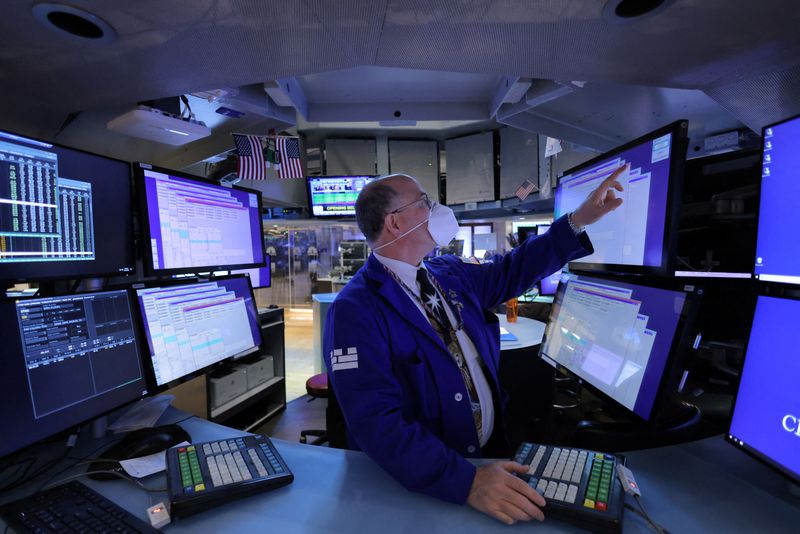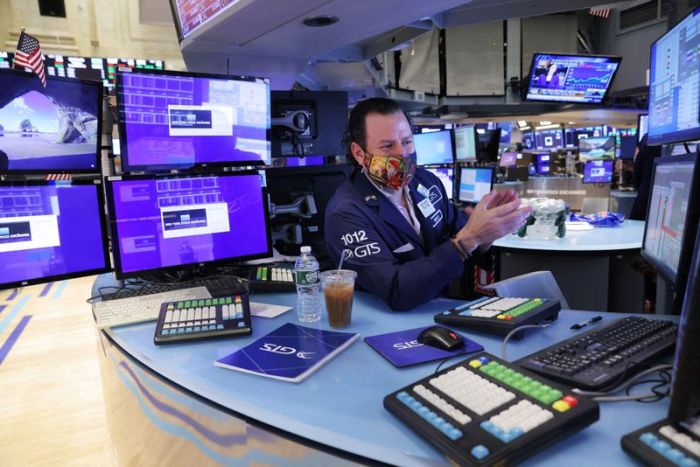NEW YORK (Reuters) – Wall Street edged lower in light trading on Friday, with investors taking a breather as they prepared to ring in the new year and close the books on 2021, marking the second year of recovery from a global pandemic.
All three major U.S. stock indexes are set for weekly, monthly, quarterly and annual gains, notching their biggest three-year advance since 1999.
The S&P 500 is on course for a 27% increase since the last trading day of 2020. Through Thursday, the benchmark index has registered 70 record-high closes, or the second-most ever. Using Refinitiv data back to 1928, the most SPX record-high closes in a single year was 77 in 1995.
Companies, consumers and the broader economy largely thrived in 2021 as they felt their way forward amid a constantly shifting landscape including a tumultuous transfer of power marked by the Jan. 6 Capitol riot. Other factors included the “meme stock” phenomenon, new COVID-19 variants, a labor shortage, generous fiscal/monetary stimulus, hobbled supply chains, booming demand and the resulting price spikes.
“What stands out to us this year among all the negatives, is the resiliency of Corporate America,” said Ryan Detrick, chief market strategist at LPL Financial in Charlotte, North Carolina. “In a sea of uncertainty and higher prices, you have to be extremely impressed by how agile and adaptive Corporate America was to sport 45% earnings growth in a very difficult year.”
Indeed, earnings results from S&P 500 companies blew past analyst estimates to deliver year-on-year growth in the first three quarters of the year of 52.8%, 96.3% and 42.6%, respectively, according to Refinitiv, which currently sees fourth-quarter annual earnings growth of 22.3%.
Energy, real estate and microchips, sectors associated with economic recovery and booming demand, were among 2021’s top performers, with growth stocks’ 31% advance handily outperforming the 22% gain in value stocks.
Market-leading tech and tech-adjacent megacap stocks, which outperformed the broader market in the first year of the global health crisis, were laggards as the economy slowly reopened and vaccines were deployed.
The NYSE FANG+ index, an equal-weighted group of ten such stocks, is on track to notch a nearly 20% advance on the year. Google parent Alphabet Inc is on track to post the biggest annual advance among NYSE FANG+ constituents, enjoying its best year since 2009.
Dow Transports, considered by many a barometer of economic health, is on track to register a yearly gain of more than 31%.
Steadily rising Treasury yields – along with a recent hawkish shift from the Federal Reserve, which now foresees as many as three rate hikes in the coming year – have supported interest rate-sensitive financials which gained nearly 33%.
The COVID-19 pandemic, which burst onto the scene in early 2020 and prompted the steepest, quickest economic contraction in history, continues to linger, pressuring travel-related stocks.
The S&P 1500 Airlines index is on track to be among 2021’s few losing sectors, setting course for an annual decline of nearly 2%.
But early data suggests the Omicron variant, which has caused an abrupt spike in global infections of the disease, is less virulent than its predecessors, and economic data is increasingly suggesting a return to normal, two years after the first cases of COVID-19 were reported.
The Dow Jones Industrial Average fell 69.05 points, or 0.19%, to 36,329.03, the S&P 500 lost 5.03 points, or 0.11%, to 4,773.7 and the Nasdaq Composite dropped 31.63 points, or 0.2%, to 15,709.93.
Of the 11 major sectors in the S&P 500, real estate was last up the most in Friday’s session, with communications services suffering the biggest percentage drop.
Advancing issues outnumbered declining ones on the NYSE by a 1.16-to-1 ratio; on Nasdaq, a 1.08-to-1 ratio favored decliners.
The S&P 500 posted 24 new 52-week highs and no new lows; the Nasdaq Composite recorded 29 new highs and 70 new lows. (This story refiles to add dropped words in paragraph 11)
(Reporting by Stephen Culp in New York; Additional reporting by Medha Singh in Bangalore; Editing by Matthew Lewis)
















